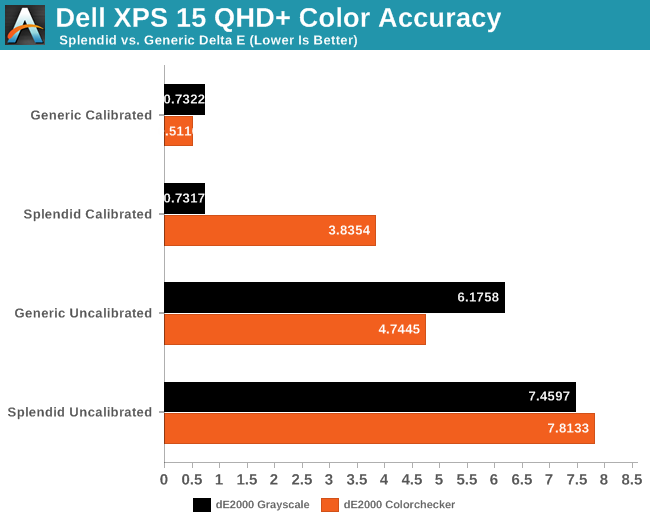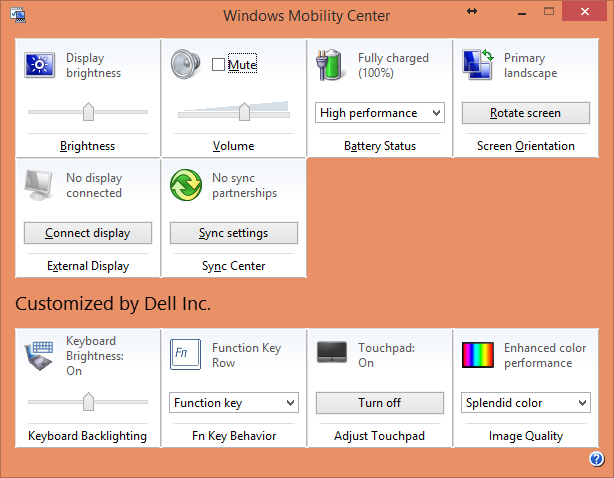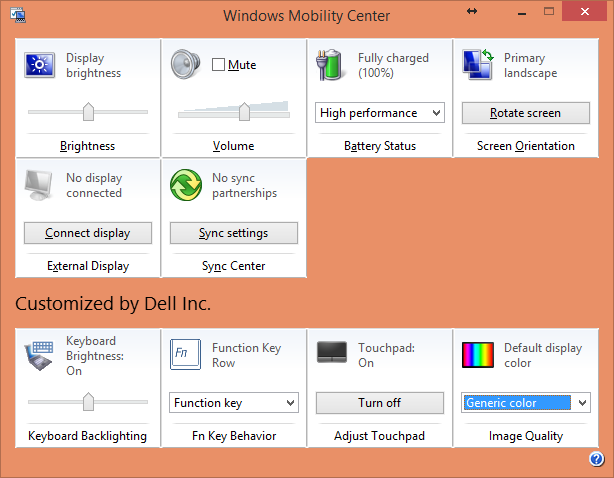Dell XPS 15 QHD+: Revisiting the LCD Results
by Jarred Walton on March 20, 2014 3:40 PM EST_678x452.JPG)
When I posted the review of the Dell XPS 15 last week, the display was one of the highlights, though not without problems. The biggest issue of course is dealing with the large number of Windows apps that don’t support the high DPI API; there’s not much to be done there other than to wait and let the application developers work things out – and they will, considering the number of high DPI displays coming down the pipe! The other issue was that the out-of-box colors weren’t all that great (oversaturated), and even after calibration there were still a few small quirks with the colors. Well, we received word from one of our readers that the problem with the colors can at least be partially fixed by disabling the “Splendid color" mode, so I set about retesting the display.
First things first, if you have this particular laptop and are wondering where Splendid mode is set, you have to go into the Windows Mobility Center. You can see the “Enhanced color performance” setting in the above images, which of course look the same on your display as the setting only changes my LCD’s LUTs (Look Up Tables) but trust me: they're not the same. Apparently Dell sets Splendid color mode initially, and unless you specifically go looking for the setting you’ll likely miss it – as I did. Here’s where things get a bit odd….
My initial results after calibration were quite good, even with the display being set to Splendid mode. Now I can’t reproduce those numbers. What I can reproduce is similar numbers with the display set to “Generic color” (within the Windows Mobility Center settings), but they’re actually better than before. As this is the first display I’ve tested with the new software/hardware, I’m still learning a few things, but if you have an XPS 15 with the QHD+ display and you can’t get the colors to look right, hopefully enabling the “Generic color” setting will help you out.
So how does the XPS 15 QHD+ panel perform with the Generic color profile compared to the Splendid profile? Here are the uncalibrated/calibrated results and charts from both modes, separated into four galleries.
As expected, the uncalibrated color accuracy on the Splendid mode is quite a bit worse than that of the generic color profile – Splendid clearly oversaturates certain colors. However, the main difference is that Splendid apparently kills the red levels where the other blue and green components are in some cases slightly better than the Generic profile. Overall, though, Splendid definitely isn’t what I would choose for proper colors. In general, the default colors in either mode aren’t that great, which is why we’d really like Dell (and others with these high-end panels) to factory calibrate. Let’s move on to the calibrated colors, though….
And there’s what we were hoping for. The calibrated colors on the XPS 15 QHD+ panel were good before, but now they’re nearly perfect. What’s more, by going back to the calibration I have consistently been unable to recreate the earlier calibrated Splendid results. My best guess is that perhaps the unit I’m testing this on somehow had the Splendid profile modified so that it was more like the Generic mode, but after a full DCC reset I get the above results. And what they show is that even with calibration, I’m unable to fully correct the problems with oversaturated reds, and that throws some of the other colors off as well. Here's a quick summary of the average Delta E for the grayscale and Colorchecker charts.

Long story short, then: if you want better colors on the Dell XPS 15, use the Generic color profile. Pre-calibration it’s at least better than average, and post-calibration all of the tested points are below 2.0 dE, with the average being below 1.0 – essentially perfect. If Dell – or someone else – can deliver a laptop with that sort of color accuracy out of the box, we’d definitely be talking about Editors’ Choice material – for the display if not for the laptop as a whole. For imaging professionals, the combination of a high DPI PPS (like IPS) panel (e.g. “future proof”) that calibrates to nearly perfect colors is the best we have ever tested. Worst-case, you can run the panel at 1080p with 100% scaling and wait for the apps to properly support high DPI; best case, you could run QHD+ resolution and have even more screen real estate to work on editing videos, photos, etc.




































33 Comments
View All Comments
rpagespollo - Thursday, May 22, 2014 - link
Has someone checked the unit with a 1080p display? There is a lower configuration with a 1080p display instead of the HiDPI display.n8turepix - Saturday, April 25, 2015 - link
Jarred, thanks for doing this excellent work. I have a question and comment. When using i1Profiler to calibrate, it wants to know the display type (CCFL, white LED, color LED, etc.) I took a guess at white LED. Is that right?The comment: For newer laptops, it appears that Splendid Color has now gone away. There is now an Intel HD Graphics Control Panel app that controls display settings. There are options to adjust color enhancement and saturation, but not having your instruments I don't know what the best settings would be. If you can get access to a new machine, the right settings for the new app would be most useful. I did all the other workarounds mentioned here with disabling Secure Boot but the Mobility Center does not show the control for Splendid Color. Dell Support says it's not in the build for this model of the XPS 15 (March 2015).
n8turepix - Saturday, April 25, 2015 - link
Some other comments on this laptop. Display brightness does fluctuate a lot when on battery. There are options to turn this off, but of course battery life will suffer. For critical work, plug in to AC power. This is also a bright display, and it helps to calibrate for both the native brightness and 120 nits.